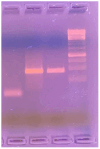Vasculonecrotic Reaction Caused by Mycobacterium Lepromatosis Infection-A Case Report of an HIV/Leprosy-Coinfected Patient
- PMID: 40559189
- PMCID: PMC12193240
- DOI: 10.3390/idr17030058
Vasculonecrotic Reaction Caused by Mycobacterium Lepromatosis Infection-A Case Report of an HIV/Leprosy-Coinfected Patient
Abstract
Background: Vasculonecrotic reactions in leprosy are typically associated with type 2 reactions. Differentiating between necrotizing erythema nodosum leprosum (nENL) and Lucio's phenomenon (LP) can be difficult, as overlapping clinical and histopathological features have been reported. Mycobacterium lepromatosis, a recently identified species causing leprosy, has been sporadically linked to LP. While type 1 reactions are more commonly observed in HIV-coinfected individuals, reports of LP or ENL occurring outside the context of immune reconstitution inflammatory syndrome (IRIS) remain rare.
Methods: We report a case of a vasculonecrotic leprosy reaction due to M. lepromatosis in an antiretroviral-naive patient with advanced HIV infection.
Results: The patient presented with a two-month history of papules and nodules that progressed to painful necrotic ulcers, accompanied by systemic symptoms. Clinically, the presentation was consistent with nENL; however, histopathological analysis supported a diagnosis of LP. The patient rapidly deteriorated, developing septic shock and dying shortly thereafter. To our knowledge, this is the first reported case of a leprosy-associated vasculonecrotic reaction caused by M. lepromatosis in an HIV-infected individual not associated with IRIS.
Conclusions: Vasculonecrotic reactions in leprosy are life-threatening emergencies due to their potential for rapid clinical deterioration and sepsis. In individuals with advanced HIV infection, recognition of these reactions may be challenging, as they can mimic other opportunistic infections, including fungal diseases, malignant syphilis, and disseminated mycobacterial infections. Early identification and prompt treatment are critical to improving outcomes.
Keywords: HIV infection; Lucio’s phenomenon; Mycobacterium lepromatosis; leprosy; leprosy reactions; necrotizing erythema nodosum leprosum; vasculonecrotic reaction.
Conflict of interest statement
The authors declare no conflicts of interest.
Figures



References
-
- Singh P., Benjak A., Schuenemann V.J., Herbig A., Avanzi C., Busso P., Nieselt K., Krause J., Vera-Cabrera L., Cole S.T. Insight into the evolution and origin of leprosy bacilli from the genome sequence of Mycobacterium lepromatosis. Proc. Natl. Acad. Sci. USA. 2015;112:4459–4464. doi: 10.1073/pnas.1421504112. - DOI - PMC - PubMed
-
- Antunes D.E., Santos D.F., Lima M.I.S., Caixeta L.P., Correa M.B.C., Moraes E.C.d.S., Conceição N.C.A., Goulart L.R., Goulart I.M.B. Clinical, epidemiological, and laboratory prognostic factors in patients with leprosy reactions: A 10-year retrospective cohort study. Front. Med. 2022;9:841030. doi: 10.3389/fmed.2022.841030. - DOI - PMC - PubMed
Publication types
LinkOut - more resources
Full Text Sources

